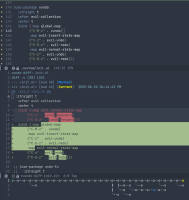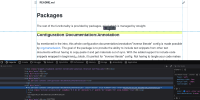Emacs
URL shortening for blog links natively in Hugo
This blog post can also be found at 1ba87346. This short URL is designed to make sharing online more compact without having to use an external URL shortening service. The permalink for this post is 62 characters (plus base URL, everything following discounts the base URL), while the short URL is 11 characters. Every post will predictably be 11 characters since I’m using CRC32 hash of the permalink to generate the short link....
Markdown anchor linking on Github
I’ve been using org-transclusion for an “inverse literate” Emacs config and tangling all the config chunks on save and exporting it as a markdown file. This has worked fairly well except for the fact that org-export creates org-export regenerates ids for all the headings which creates noise in the git commit history and also in-page anchors can’t be reliably linked to a specific part of the document (independent of the git forge’s markdown parsing implementation)....
Setting up Protonmail in Emacs
I’ve used Protonmail for several years and use the web interface for the most part and used Thunderbird on the desktop to keep offline copies of email. Since Protnmail takes care of the encryption it requires a local bridge to provide a standard interface like IMAP. Essentially, it is running an IMAP server on the local machine that any compatible client can connect to. Technically, the bridge can be made accessible on a local network so many clients from many machines can connect to it....
"Inverse literate" config via org-transclusion
I am very intrigued by the whole concept of literate programming. There is a lot of opinions and lots of valid points for and against comments, but ultimately it’s always a good idea to understand intent. I wanted to create a literate config but did not want slow down startup with tangling. I came across an interesting package today called org-transclusion by @nobiot. The package is very interesting, being able to bring in arbitrary lines of text from multiple documents into a single document (while those documents remain the source of truth) is quite powerful....
Doom Emacs config (deprecated)
I was asked about my Doom config by someone on fosstodon but it’s not a clean repo where I’m not confident that I didn’t accidentally commit private information in the past, so I wasn’t sure how to share. But this is a good time to put a pin in the config and capture a snapshot here, for reference. This is quite messy and mixes idioms at random as I learned more about configuration....
Emacs which-key prefix labels
I’ve been using evil-mode for my Emacs configuration and evil-leader makes the key-mapping very straight-forward with the set-key. I wanted a few functions to be grouped together. SPC is bound as a leader key and there are a few frequent functions bound to single keys, the rest are grouped under other leaders. However, the secondary leaders show up as x → +prefix and it would nice to give the grouping a name....
Emacs custom configuration
I crafted a custom configuration for Emacs and have been using it for the past few weeks. This is something I didn’t really see myself doing when I started using Emacs, it seemed “very advanced”. This was my journey from a noob to a different kind of noob! Doom I started my Emacs journey with Doom and was learning things along the way. This was a great way to get started by borrowing configuration snippets and blindly copying and pasting, which got me up and running quickly....
org-bars view for outlining/folding
I came across this new org-bars package that shows folding indicators and lines to indicate the groupings. In a forum discussion I also discovered that there’s another package org-visual-outline but it actually requires configuring two packages so I didn’t try it. However, based on the discussion in the comments it seems that org-bars supports narrowing of the buffer (and it works great) which visual-outline does not. I discovered a visual bug and filed a report, so hopefully it’s an easy fix but it’s not a breaking issue....
Fully automated deployment
Up until the last commit, the site was being written in Org Mode, exported using ox-hugo, and Hugo was invoked manually to generate the html all locally. The generated public folder was what was being pushed to SourceHut for the deployment. This will be first post which will only commit the actual content in org format only and the full CI/CD will happen on SourceHut. Using org-publish I’ll be following along with the System Crafters’ Publishing Website with Org Mode to take full advantage of org-publish and configure multiple outputs (WWW and Gemini)....


